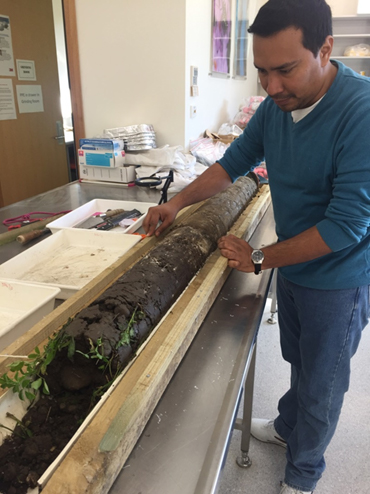Contrasting microbial activities in topsoil and subsoil
In this section
-
Reducing nitrogen losses from farms
- Measuring and modelling paddock water inputs and losses on stony soils
- Annual net inputs and losses of carbon and nitrogen for irrigated and non-irrigated lucerne
- Carbon inputs to reduce nitrogen losses
- Sward species and cattle diet effects on nitrogen losses
- Contrasting microbial activities in topsoil and subsoil
- Identifying soils with low nitrogen losses
- Mauriora Systems Framework: A guide and process for decision-making
- Recommendations for farmers
Key findings
- Soil microbial activity regulates carbon and nitrogen cycling in soils and manipulating microbial diversity can lead to changes in nitrogen losses
- We examined soil microbial activity in topsoil (depth 0-0.1m) and subsoil (depth 0.3-0.5m) to determine differences in the drivers of microbial activity
- We found that in the topsoil, nitrate concentrations were independent of microbial variables. In contrast, in the subsoil, nitrate concentration was driven by microbial processes that are the precursors of nitrogen losses. Subsoil processes may be more important in regulating nitrogen leaching losses that recognised previously

Soil core extracted to a depth of 1.5 m from lucerne to collect samples for analysis of the microbial processes regulating carbon and nitrogen cycling
In soil, inputs of nitrogen are converted to nitrate (nitrification) that can be used by plants, leached as nitrate or converted to nitrous oxide and nitrogen gas (denitrification). Understanding the drivers of these processes is needed to identify management practices that will lead to reducing nitrogen losses.
Jonathan Nuñez, a PhD student at the University of Canterbury with colleagues from Manaaki Whenua – Landcare Research and Lincoln University collected deep soil cores under irrigated lucerne and analysed data on microbial activity and abundance of key genes regulating nitrogen cycling in topsoil (depth 0-0.1m) and subsoil (depth 0.3-0.5m). With high nitrogen availability in the topsoil, nitrate concentrations were independent of microbial variables and their drivers. In contrast, in the subsoil, nitrate concentrations were driven by the abundance of bacteria and denitrification enzyme activity that are both regulated by the size of the pool of mineralisable N. In the subsoil, but not in the topsoil, bacterial species richness had an indirect effect on nitrate concentration. We showed that microbial properties are the dominant regulators of nitrogen cycling in the subsoil and are important for regulating nitrate concentration that is a precursor of nitrogen leaching losses.
We conclude that manipulating soils with low nitrogen concentration to reduce leaching losses may be achieved by reducing nitrogen inputs in topsoil and managing carbon inputs from plants or amendments into subsoil to promote nitrogen immobilisation and enzyme activity to reduce nitrate concentrations.
